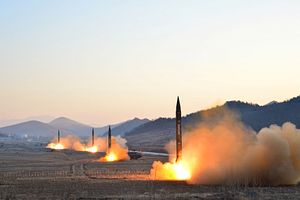North Korea’s launch of several ballistic missiles into the Sea of Japan on Monday indicates progress in the isolated state’s missile capabilities, according to experts.
Pyongyang fired four missiles from its west coast at about 7 am local time. Three of the missiles landed close together within an area of sea situated 300-350 km from the Japanese mainland.
Prime Minister Shinzo Abe sharply condemned the launches, which came as the United States and its ally South Korea were conducting joint military drills, calling them a “new threat” from North Korea.
The Korean Central News Agency, Pyongyang’s official mouthpiece, said on Tuesday the launches were practice for striking the “U.S. imperialist aggressor forces” in Japan, referring to the some 50,000 American soldiers stationed in the country.
In phone talks with Abe on Tuesday, U.S. President Donald Trump reportedly told his counterpart that the United States was behind its ally “100 percent.” On the same day, American troops in South Korea began to deploy THAAD, an anti-missile system designed to defend against North Korea.
Although North Korea vowed in January to soon test an intercontinental ballistic missile capable of reaching the U.S. mainland, analysts said the latest missiles launches appeared to be of extended-range Scuds capable of traveling around 1,000 km.
But the launch of several missiles in quick succession without detection was still seen by analysts as a significant step forward for the regime’s missile capabilities.
Nathan Hunt, an analyst for Washington-based defense contractor Strategic Sentinel, told The Diplomat that Pyongyang had made progress in its “operational capability” for wartime.
“This was pretty much a major development because it shows their capability of moving these missiles, fueling, and firing in a short amount of time,” Hunt said.
Hunt also noted that the missiles were fired with enough accuracy for three of them to land close together in the sea.
“For them to all hit at pretty much a close grouping, that proves it wasn’t just a random splashdown because even a slight skewing in one direction can make it go off course by miles and miles,” he said.
“This is pretty impressive that they did a four-missile launch and that they managed to get three of those to land in a pretty close grouping.”
Hunt said Pyongyang could now be expected to concentrate on developing solid-fuel missiles, which can be deployed much more rapidly as they don’t require fueling. North Korea carried out a test of a solid-fuel engine at the same launch site in April, and last month fired an intermediate-range ballistic missile that is believed to have relied on solid fuel.
“That’s why the fact they are now moving to fuel these solid state missiles is very critical because they’ve now removed that [time element] from the equation and they can now rapidly do surprise launches with very little warning.”

































